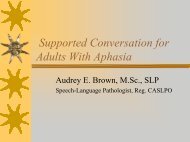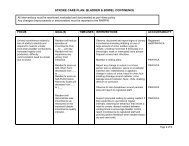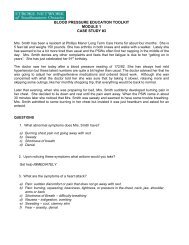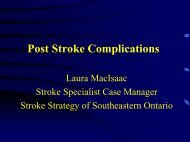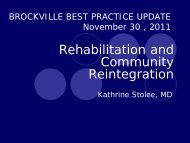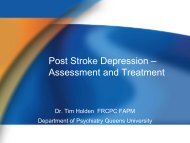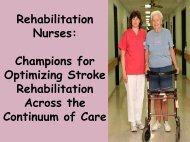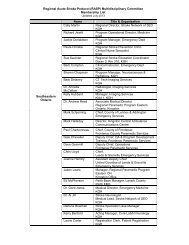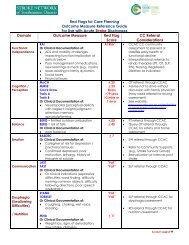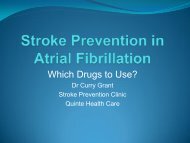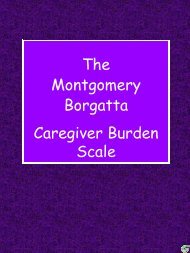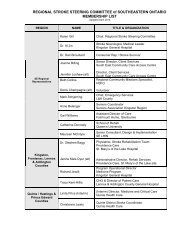Understanding and Using the Systems Theory of Motor Control in ...
Understanding and Using the Systems Theory of Motor Control in ...
Understanding and Using the Systems Theory of Motor Control in ...
You also want an ePaper? Increase the reach of your titles
YUMPU automatically turns print PDFs into web optimized ePapers that Google loves.
<strong>Underst<strong>and</strong><strong>in</strong>g</strong> <strong>and</strong> <strong>Us<strong>in</strong>g</strong> <strong>the</strong><strong>Systems</strong> <strong>Theory</strong> <strong>of</strong> <strong>Motor</strong> <strong>Control</strong> <strong>in</strong><strong>the</strong> Assessment <strong>and</strong> Treatment <strong>of</strong><strong>the</strong> Upper ExtremityBy: Marianne Lawton, B.Sc. PTInstructor Bobath/NDT, IBITA
Voluntary Movement• is made <strong>in</strong>tentionally• guided by perception (for example vision)• planned <strong>and</strong> <strong>the</strong>n executed by output <strong>of</strong>motor comm<strong>and</strong>s which specify <strong>the</strong> correctsequence <strong>of</strong> muscle activation• sensory feedback can be used to optimizeperformance.
• Active Movement requiresPostural Support for Balance<strong>Control</strong>
Arm Function• Support <strong>and</strong> Mobility• Balance <strong>and</strong> Walk<strong>in</strong>g• Protection• Manipulation• Sensation
Movement <strong>Control</strong>All areas <strong>of</strong> <strong>the</strong> bra<strong>in</strong>, <strong>in</strong>clud<strong>in</strong>g visual <strong>and</strong>auditory cortices, are directly or <strong>in</strong>directly<strong>in</strong>volved <strong>in</strong> motor control.Interconnectivity between cortical areas willimpact movementMore complex <strong>the</strong> movement, <strong>the</strong> morecortical networks <strong>in</strong>volved.
Cortex to Sp<strong>in</strong>al Pathways• Lateral Corticosp<strong>in</strong>al Tract• ma<strong>in</strong>ly supplies <strong>the</strong> most distal muscles <strong>of</strong> <strong>the</strong> limbs<strong>and</strong> specifically for precise movements such as <strong>the</strong>h<strong>and</strong>• Completes <strong>the</strong> plann<strong>in</strong>g <strong>of</strong> voluntary movements <strong>and</strong><strong>the</strong> elaboration <strong>of</strong> motor comm<strong>and</strong>s for <strong>the</strong>ir execution• Anterior Corticosp<strong>in</strong>al Tract• ma<strong>in</strong>ly <strong>in</strong>nervates <strong>the</strong> axial (trunk) muscles• uncrossed fibres
<strong>Motor</strong> <strong>Control</strong> Pathways• Corticosp<strong>in</strong>al system orig<strong>in</strong>ates <strong>in</strong> bothmotor <strong>and</strong> sensory regions <strong>of</strong> <strong>the</strong>cerebral cortex.
Orig<strong>in</strong>s <strong>of</strong> Corticosp<strong>in</strong>al Pathways• Areas• 4 (Primary motor cortex) 1/3 distribution to h<strong>and</strong>/face/rest<strong>of</strong> body. Provides selectivity, skill <strong>and</strong> precision <strong>in</strong>movement• 6 (Supplementary motor cortex <strong>and</strong> premotor motor cortex)adjusts <strong>the</strong> manner <strong>in</strong> which <strong>the</strong> sp<strong>in</strong>al cord responds to <strong>the</strong>peripheral <strong>in</strong>put• 3,1,2, (Primary somatosensory cortex)/ 5,7, (Posteriorparietal cortex) adjusts transmission <strong>of</strong> <strong>the</strong> sensorypathways <strong>in</strong>clud<strong>in</strong>g stereognosis <strong>and</strong> discrim<strong>in</strong>atorysensation
Corticosp<strong>in</strong>al Tracts• Directs active movement control• Allows for f<strong>in</strong>e tun<strong>in</strong>g <strong>of</strong> volitional movementsespecially skilled, <strong>in</strong>dependent f<strong>in</strong>ger control• Responsible <strong>of</strong> Skill <strong>and</strong> Precision <strong>in</strong> Movement by<strong>in</strong>corporat<strong>in</strong>g visual <strong>and</strong> auditory <strong>in</strong>formation.• <strong>Control</strong>s <strong>the</strong> rate <strong>and</strong> rhythm <strong>of</strong> automatic movementprograms• Directs speed & agility to voluntarymovements→perform<strong>in</strong>g rapid skilled movements• Not a Robust System
<strong>Motor</strong> Cortex• Divided <strong>in</strong>to three reciprocally<strong>in</strong>terconnected areas <strong>in</strong>clud<strong>in</strong>g:• Primary <strong>Motor</strong> Area• Secondary <strong>Motor</strong> Area• comprised <strong>of</strong> Supplementary <strong>Motor</strong> Area <strong>and</strong><strong>the</strong> Premotor Area
<strong>Motor</strong> Program Recruitment• Secondary <strong>Motor</strong> areas forms a loop with <strong>the</strong>Basal Ganglia• Primary <strong>Motor</strong> area forms a loop with <strong>the</strong>cerebellum
Primary <strong>Motor</strong> Area• First cortical area directly associatedwith motor function.• Has much more cortical space devotedto regions such as <strong>the</strong> h<strong>and</strong>s <strong>and</strong> facewhere <strong>the</strong> variety <strong>and</strong> complexity <strong>of</strong>movements is greatest• Primary <strong>Motor</strong> Area is made up <strong>of</strong> 40%<strong>of</strong> Pyramidal Tract Fibres
Primary <strong>Motor</strong> Area cont<strong>in</strong>ued• Receives a somatopic projection from <strong>the</strong>somatosensory cortex• part <strong>of</strong> <strong>the</strong> <strong>in</strong>put is from <strong>the</strong> muscle sp<strong>in</strong>dles<strong>and</strong> is <strong>the</strong> sensory side to <strong>the</strong> stretch reflex• neurons <strong>in</strong> <strong>the</strong> motor cortex correlate with awide variety <strong>of</strong> movement parameters<strong>in</strong>clud<strong>in</strong>g force, velocity <strong>and</strong> direction.
Secondary <strong>Motor</strong> Area• Involved <strong>in</strong> plann<strong>in</strong>g movements• its neurons fire hundreds <strong>of</strong>milliseconds before a movement beg<strong>in</strong>s.• Comprised <strong>of</strong> two parts: Supplementary<strong>Motor</strong> Area <strong>and</strong> <strong>the</strong> Premotor Area
Supplementary <strong>Motor</strong> Cortex• is crucial for perform<strong>in</strong>g complicated tasks<strong>in</strong>volv<strong>in</strong>g both sides <strong>of</strong> <strong>the</strong> body such as twoh<strong>and</strong>ed activities• <strong>in</strong>volved <strong>in</strong> perform<strong>in</strong>g complex sequences <strong>of</strong>movement that have been previously learned• is more active <strong>in</strong> sequential motor tasks <strong>and</strong>is <strong>in</strong>ternally generated.
Premotor Area• primarily concerned with plann<strong>in</strong>g movementsthat require sensory cues (primarily visual)• receives a large <strong>in</strong>put from <strong>the</strong> posteriorparietal cortex (Brodman 5, 7)• provides sensory <strong>in</strong>put for targeted areas <strong>and</strong>action is context specific i.e. reach<strong>in</strong>g forfood.
Premotor Area cont<strong>in</strong>ued• have direct projections to <strong>the</strong> sp<strong>in</strong>al cord, butnot as extensive as from <strong>the</strong> <strong>Motor</strong> Cortex.• Involved primarily <strong>in</strong> plann<strong>in</strong>g <strong>and</strong> <strong>in</strong>itiation <strong>of</strong>centrally programmed motor comm<strong>and</strong>s.• Involved <strong>in</strong> establishment <strong>of</strong> <strong>the</strong> postural setrequired for a specific task.
Premotor Area cont<strong>in</strong>ued• Involved <strong>in</strong> activities that require sequenc<strong>in</strong>g<strong>of</strong> goal directed movements; for example,typ<strong>in</strong>g or a remembered sequence• Less active dur<strong>in</strong>g repetitive simplemovements such as f<strong>in</strong>ger tapp<strong>in</strong>g
Primary Somatosensory Area• Most cells fire <strong>in</strong> this area after <strong>the</strong>movement starts.• Cells respond to sensory feedbacksignals generated by movement.• Information transported via <strong>the</strong>thalamus, <strong>the</strong>n to primarysomatosensory areas.
Primary Somatosensory Areacont<strong>in</strong>ued…• Multiple sensory fields <strong>in</strong> eachsomatosensory area that respondsspecifically to a somatosensory <strong>in</strong>put;for example, light touch muscle stretch.• Richly connected with<strong>in</strong> <strong>the</strong> bra<strong>in</strong>• Projects to <strong>the</strong> sp<strong>in</strong>al cord, bra<strong>in</strong> stem<strong>and</strong> thalamus, <strong>the</strong>refore control sensory<strong>in</strong>put to <strong>the</strong> cerebral cortex.
Somatosensory <strong>Motor</strong> Cortex vs.Pre <strong>Motor</strong> Cortex• Both are active dur<strong>in</strong>g learn<strong>in</strong>g <strong>of</strong> amotor task.• Pre motor cortex is more <strong>in</strong>volved withmovements that rely on sensory <strong>in</strong>putsfrom <strong>the</strong> environment, such as vision<strong>and</strong> proprioception.
Somatosensory <strong>Motor</strong> Cortex vs.Pre <strong>Motor</strong> Cortex cont<strong>in</strong>ued…• Somatosensory motor cortex are active <strong>in</strong>skills that require plann<strong>in</strong>g severalmovements ahead, particularly any tasks thatrequire temporal order<strong>in</strong>g <strong>of</strong> proximal <strong>and</strong>distal movements.• Pre motor areas respond to changes <strong>in</strong>sensory <strong>in</strong>put dur<strong>in</strong>g complex movement ordur<strong>in</strong>g perturbations <strong>of</strong> <strong>the</strong> movement.
Modulation <strong>of</strong> Voluntary <strong>Control</strong>• The <strong>Motor</strong> Cortex alters its output depend<strong>in</strong>gon its afferent <strong>in</strong>put, <strong>the</strong>refore responsive tosomatosensory <strong>in</strong>formation received.• Because <strong>the</strong> pyramidal tract neurons <strong>of</strong> <strong>the</strong><strong>Motor</strong> Cortex are also active beforemovement, <strong>the</strong>y appear to contribute to <strong>the</strong>establishment <strong>of</strong> <strong>the</strong> postural set required for<strong>the</strong> desired movement.• Allows feedback <strong>and</strong> feed forward loop.
Intentional Movement: Reach<strong>in</strong>g• Movements that are made <strong>in</strong>tentionally to achieve aparticular aim or reach a target• Involves several <strong>in</strong>dependent processes• perceptual <strong>in</strong>put may evoke or guide it (for examplevisual <strong>in</strong>put)• requires plann<strong>in</strong>g as different motor tasks can beperformed <strong>in</strong> various ways• this is called <strong>Motor</strong> Equivalence
<strong>Motor</strong> Equivalence• plann<strong>in</strong>g is required to organize preciselywhich set <strong>of</strong> postural adjustments should berecruited at <strong>the</strong> start <strong>and</strong> dur<strong>in</strong>g <strong>the</strong>movements• executed by <strong>the</strong> output <strong>of</strong> motor comm<strong>and</strong>swhich specify <strong>the</strong> correct tim<strong>in</strong>g <strong>of</strong> muscleactivation• sensory feedback dur<strong>in</strong>g <strong>the</strong> movement f<strong>in</strong>etune <strong>the</strong> execution to ensure that <strong>the</strong>performance matches <strong>the</strong> desired goal.
Cl<strong>in</strong>ical Manifestations <strong>of</strong> Damageto <strong>Motor</strong> Areas• Difficult to be exact <strong>in</strong> def<strong>in</strong>ition s<strong>in</strong>ce cortical areasdo not work <strong>in</strong> isolation.• Generally motor cortex damage results <strong>in</strong>:• Permanent deterioration <strong>in</strong> <strong>the</strong> ability to make f<strong>in</strong>e<strong>in</strong>dependent movements <strong>of</strong> <strong>the</strong> h<strong>and</strong>• Loss <strong>of</strong> contralateral h<strong>and</strong> orientat<strong>in</strong>g responses• Disruption <strong>of</strong> <strong>the</strong> sensory motor l<strong>in</strong>kage, particularly spatialadjustments• Destruction <strong>in</strong> <strong>in</strong>ternal capsule – contralateral hemiplegia<strong>in</strong>itially flaccid, later spastic ; most marked <strong>in</strong> distal muscles
Cl<strong>in</strong>ical Manifestations <strong>of</strong> Damageto <strong>Motor</strong> Areas cont<strong>in</strong>ued• Primary <strong>Motor</strong> Area:• muscle paresis spasticity <strong>and</strong> difficulties withmulti-jo<strong>in</strong>t movements on <strong>the</strong> same side <strong>of</strong> <strong>the</strong>face <strong>and</strong> <strong>the</strong> contralateral side <strong>of</strong> <strong>the</strong> body.• Loss <strong>of</strong> fractionation <strong>of</strong> movement
Cl<strong>in</strong>ical Manifestations <strong>of</strong> Damageto <strong>Motor</strong> Areas cont<strong>in</strong>ued• Premotor Area:• similar <strong>in</strong> presentation as to primary• weakness tends to <strong>in</strong>volve more proximal jo<strong>in</strong>tweakness especially hip <strong>and</strong> shoulder• motor plann<strong>in</strong>g skills are affected i.e. can reachfor an object but not manipulate <strong>the</strong> object• bilateral activities are affected
Cl<strong>in</strong>ical Manifestations <strong>of</strong> Damageto <strong>Motor</strong> Areas cont<strong>in</strong>ued• Supplementary <strong>Motor</strong> Cortex• affect bilateral arm <strong>and</strong> h<strong>and</strong> movements but <strong>the</strong>problems are most apparent not dur<strong>in</strong>g visuallyguided movements but ra<strong>the</strong>r movements madebased on patterns or sequences• ak<strong>in</strong>esis <strong>of</strong> movement where loss <strong>of</strong> plann<strong>in</strong>g formovement control
Cl<strong>in</strong>ical Manifestations <strong>of</strong> Damageto <strong>Motor</strong> Areas cont<strong>in</strong>ued• Primary Somatosensory Area• contralateral sensory loss• possible loss <strong>of</strong> stereognosis• because limb position sense can be affected atype <strong>of</strong> sensory ataxia can occur where <strong>the</strong> patientappears uncoord<strong>in</strong>ated dur<strong>in</strong>g attempted limbmovements
Cl<strong>in</strong>ical Implications <strong>in</strong> Therapy• Most <strong>in</strong>terest<strong>in</strong>g th<strong>in</strong>gs to <strong>the</strong> CNS issometh<strong>in</strong>g new <strong>and</strong> novel• Therapists should produce a stimulussignificant to <strong>the</strong> patient that relates to <strong>the</strong>irCNS at a moment <strong>in</strong> time to allow for<strong>in</strong>tegration <strong>of</strong> sensory proprioceptive control• Individual differences - some respond tocognitive <strong>and</strong> some sensory- assess response<strong>of</strong> patient



